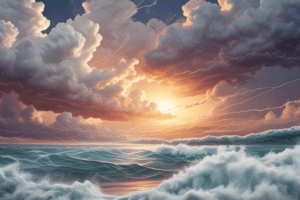Podcast
Questions and Answers
Which characteristic is NOT a primary factor in classifying an air mass?
Which characteristic is NOT a primary factor in classifying an air mass?
- Humidity
- Temperature
- Source region latitude
- Stability (correct)
Which of the following best describes a maritime polar (mP) air mass?
Which of the following best describes a maritime polar (mP) air mass?
- Cold and dry
- Cold and humid (correct)
- Warm and dry
- Warm and humid
What is a key factor that dictates the direction a front moves?
What is a key factor that dictates the direction a front moves?
- The wind speed perpendicular to the front
- The way the symbols are drawn on a weather map (correct)
- The temperature difference across the frontal boundary
- The pressure gradient force along the front
Which type of front is typically associated with a wide area of light to moderate precipitation ahead of its surface position?
Which type of front is typically associated with a wide area of light to moderate precipitation ahead of its surface position?
What is the primary characteristic associated with the passage of a cold front?
What is the primary characteristic associated with the passage of a cold front?
Which stage of the Norwegian Cyclone Model is characterized by the formation of distinct warm and cold fronts extending from a central low-pressure area?
Which stage of the Norwegian Cyclone Model is characterized by the formation of distinct warm and cold fronts extending from a central low-pressure area?
According to the Norwegian Cyclone Model, what happens during the occlusion stage?
According to the Norwegian Cyclone Model, what happens during the occlusion stage?
In the context of surface cyclone intensification, what role does upper-level divergence play?
In the context of surface cyclone intensification, what role does upper-level divergence play?
What is the ideal position of an upper-level trough relative to a surface cyclone for optimal intensification?
What is the ideal position of an upper-level trough relative to a surface cyclone for optimal intensification?
What primarily causes a 'bomb cyclone' to rapidly intensify?
What primarily causes a 'bomb cyclone' to rapidly intensify?
Besides moisture and instability, what is the third essential ingredient for thunderstorm formation?
Besides moisture and instability, what is the third essential ingredient for thunderstorm formation?
What distinguishes a severe thunderstorm from an ordinary thunderstorm?
What distinguishes a severe thunderstorm from an ordinary thunderstorm?
What is a gust front, and how does it form?
What is a gust front, and how does it form?
In the context of lightning, what is the 'stepped leader'?
In the context of lightning, what is the 'stepped leader'?
Why do tropical cyclones NOT form along the equator?
Why do tropical cyclones NOT form along the equator?
What primarily causes tropical cyclones to move?
What primarily causes tropical cyclones to move?
Within a tropical cyclone, where are the strongest winds typically located?
Within a tropical cyclone, where are the strongest winds typically located?
What is the outflow in a tropical cyclone characterized by?
What is the outflow in a tropical cyclone characterized by?
What is the primary difference between a Hurricane Watch and a Hurricane Warning?
What is the primary difference between a Hurricane Watch and a Hurricane Warning?
What is the main driver of storm surge during a tropical cyclone?
What is the main driver of storm surge during a tropical cyclone?
Flashcards
Air Mass
Air Mass
A large body of air with relatively uniform temperature and humidity characteristics.
Air Mass Source Regions
Air Mass Source Regions
Regions where air masses originate; they have uniform surface conditions and are often areas of high pressure.
Air Mass Classification Factors
Air Mass Classification Factors
Based on moisture content (maritime or continental) and temperature (tropical, polar, or arctic).
Air Mass Modification
Air Mass Modification
Signup and view all the flashcards
Front
Front
Signup and view all the flashcards
Types of Fronts
Types of Fronts
Signup and view all the flashcards
Norwegian Cyclone Model
Norwegian Cyclone Model
Signup and view all the flashcards
Cyclone Intensification
Cyclone Intensification
Signup and view all the flashcards
Anticyclone Intensification
Anticyclone Intensification
Signup and view all the flashcards
Thunderstorm Ingredients
Thunderstorm Ingredients
Signup and view all the flashcards
Ordinary Thunderstorm Stages
Ordinary Thunderstorm Stages
Signup and view all the flashcards
Downburst
Downburst
Signup and view all the flashcards
Thunder
Thunder
Signup and view all the flashcards
Lightning Formation
Lightning Formation
Signup and view all the flashcards
Tropical Wave Formation
Tropical Wave Formation
Signup and view all the flashcards
No Cyclones at the Equator
No Cyclones at the Equator
Signup and view all the flashcards
TC Eye
TC Eye
Signup and view all the flashcards
Favorable TC Conditions
Favorable TC Conditions
Signup and view all the flashcards
Storm surge
Storm surge
Signup and view all the flashcards
Climate
Climate
Signup and view all the flashcards
Study Notes
Air Masses and Fronts
- An air mass is a large body of air with relatively uniform temperature and humidity characteristics.
- Air mass source regions are areas where air masses originate, generally located over large, flat areas with uniform surface conditions.
- Favorable conditions for air mass source regions include consistent temperature and moisture characteristics.
Air Mass Classification
- Air mass classification is based on two factors: moisture content and temperature.
- Five air masses commonly occur in North America: maritime tropical (mT), continental tropical (cT), maritime polar (mP), continental polar (cP), and Arctic (A).
- A maritime tropical air mass is warm and humid, often located near the Gulf of Mexico and Southeast U.S.
- Maritime tropical air masses are known for frequent thunderstorms.
Fronts
- Fronts are boundaries between different air masses.
- Types of fronts include cold, warm, occluded, and stationary, each with distinct definitions.
- Symbols and colors represent each type of front on weather maps, indicating the direction they move.
- Front identification relies on wind direction shifts, temperature changes, dewpoint changes, and pressure minima.
- Frontal passage characteristics include changes in temperature, dewpoint, pressure, wind direction, and precipitation.
- Common precipitation phenomena are associated with each type of front; squall lines tend to occur at or ahead of cold fronts while warm fronts can bring sleet or freezing rain.
Mid-Latitude Cyclones
- A mid-latitude cyclone is a large-scale weather system that occurs in the middle latitudes.
- Cyclogenesis is the development or strengthening of a cyclone.
- The Norwegian Cyclone/Polar Front Theory explains cyclone formation in steps and describes the life cycle of a cyclone.
- The warm sector in a cyclone is important as it influences the storm's development and intensity.
- Cyclogenesis is typically favored on the leeward side of mountain ranges.
- A nor'easter storm is a type of cyclone that affects the northeastern coast of North America.
- A "bomb" cyclone is a mid-latitude cyclone that intensifies rapidly, with a central pressure drop of at least 24 millibars in 24 hours.
Surface Cyclone Intensification
- Upper-level divergence plays a role in surface cyclone intensification, including jet streaks.
- The relationship between the strength of upper-level divergence and lower-level convergence affects cyclone intensity.
- The ideal position of the upper-level trough relative to the surface cyclone enhances intensification.
Surface Anticyclone Intensification
- Upper-level convergence plays a role in surface anticyclone intensification.
- The relationship between the strength of upper-level convergence and lower-level divergence affects anticyclone intensity.
- The ideal position of the upper-level ridge relative to the surface anticyclone enhances intensification.
Thunderstorms and Lightning
- Three necessary ingredients for thunderstorm formation are moisture, instability, and a lifting mechanism.
- A fourth ingredient, wind shear, is required for severe thunderstorms.
- Ordinary thunderstorms have stages of development and don't last long due to a lack of sufficient wind shear or instability.
- Severe thunderstorms last longer than ordinary thunderstorms because of their favorable atmospheric conditions.
- A gust front is a boundary separating a mass of cool, descending air from a thunderstorm from warmer, ambient air.
- Key factors for hail formation in thunderstorms are strong updrafts and supercooled water.
- Squall lines are lines of thunderstorms, typically located ahead of fronts.
- Downbursts (microbursts) are localized columns of sinking air within a thunderstorm, causing an outward burst of damaging winds at the surface.
- Downbursts pose a threat to aviation due to sudden changes in wind speed and direction.
- The region with the most thunderstorms in an average year in the U.S. is in Florida.
Lightning
- Lightning is caused by the buildup and discharge of electrical energy in the atmosphere.
- Thunder is the sound caused by the rapid heating of air around a lightning channel.
- The formation process includes a stepped leader and return stroke.
- Negative charges are typically found in the lower part of a cloud, while positive charges are on the ground.
- The first visible sign of lightning is the stepped leader.
- Types of lightning include in-cloud and cloud-to-ground.
Tropical Cyclones (TCs)
- Tropical waves and disturbances form due to atmospheric instability and convergence.
- Tropical cyclones do not form along the equator due to the Coriolis effect, which is needed for rotation.
- A hurricane and a typhoon are the same type of storm, but they are named differently based on location.
- Tropical cyclones movement is caused by a combination of steering winds and the storm's own internal dynamics.
- A tropical depression is weaker than a tropical storm, and a tropical storm is weaker than a hurricane.
TC Structure
- The eye has the lowest pressure, sinking air, and partially clear skies.
- The eyewall has the strongest winds, rising air, and powerful thunderstorms.
- Outer spiral bands bring heavy rain/thunderstorms and sometimes tornadoes on landfall.
- Outflow is the divergence of air aloft, typically anticyclonic (clockwise).
- Inflow is the convergence of near-surface air.
- TC formation, intensification, and dissipation depend on water temperature, wind shear, moisture, and surface convergence.
Factors that Weaken TCs
- Factors that cause a TC to weaken include cooler water temperatures and increased wind shear.
- Environmental conditions that favor TC intensification includes warm water temperatures.
- Tropical cyclones differ from mid-latitude cyclones in their formation mechanisms, structure, and energy sources.
- The quadrant of a tropical cyclone with the strongest winds varies by direction of motion.
- A Hurricane Watch indicates hurricane conditions are possible, while a Hurricane Warning indicates hurricane conditions are expected.
- Storm surge is an abnormal rise of water generated by a storm, caused by the storm's winds pushing water toward the shore.
Climate
- Weather refers to short-term atmospheric conditions, while climate refers to long-term patterns and averages.
- Analyzing past climate change involves comparing past global temperatures to today's and using ice cores to understand past climate.
- The primary cause of current climate warming is anthropogenic greenhouse gas emissions.
- Areas of the globe that have warmed the most include the Arctic.
- Positive feedbacks amplify warming, while negative feedbacks dampen it.
- The water-vapor greenhouse feedback and the ice-albedo feedback are examples of climate feedback mechanisms.
- Aerosols are small particles suspended in the atmosphere that can affect the climate by reflecting sunlight or influencing cloud formation.
Volcanic Eruptions
- Large volcanic eruptions can affect the climate by injecting aerosols into the stratosphere.
- Sunspots and their cycles impact climate.
- Orbital variations (Milankovitch cycles) include tilt, eccentricity, and precession, and impact climate.
- Current climate change examples include sea level rise and warmer temperatures.
- Common greenhouse gases include carbon dioxide, methane, and nitrous oxide.
- The current concentration of carbon dioxide is about 420 parts per million (ppm).
- Greenhouse gases trap heat in the atmosphere.
- Most of the warming due to greenhouse gases has gone into the oceans.
Studying That Suits You
Use AI to generate personalized quizzes and flashcards to suit your learning preferences.




